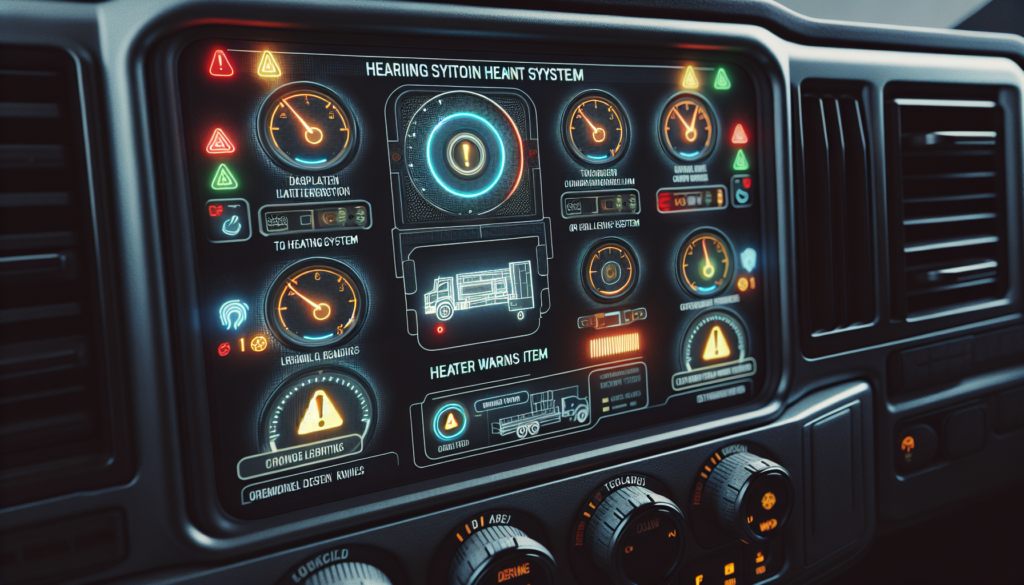
Unlocking the mysteries of your Cascadia’s heater dashboard warning lights can feel like trying to solve a puzzle! This article is here to help you decode the symbols and signals that your vehicle might be throwing your way, transforming them from enigmatic enigmas to friendly indicators of what could be going on with your heater. So sit back, relax, and equip yourself with the knowledge you need to conquer the confusion once and for all.
Understanding Your Cascadia’s Dashboard
When you climb inside your Cascadia, the dashboard is probably one of the most prominent things you’ll notice. As the driver, it’s your control panel, the place where you interact with your vehicle’s inner workings. It’s like a snapshot of your vehicle’s health at any given moment.
The Importance of Dashboard Symbols
Dashboard symbols are designed to alert you to potential problems with your vehicle. They can save you time, stress and unnecessary repair costs by notifying you of issues before they become serious. Ignoring these symbols or failing to understand what they mean can result in damages to your vehicle that could have been easily prevented.
An Overview of Common Dashboard Indicators
There are a multitude of different dashboard indicators and each one communicates a different message. Some are less serious, like your high beam indicator, while others, like the check engine light, signpost potentially serious problems. These lights typically appear when your vehicle’s computer detects an issue.
Interpreting Color Codes of Dashboard Lights
Dashboard lights come with colors similar to traffic lights where green means everything is functioning normally, yellow or orange suggests that there might be a minor issue while red is a sign of a serious problem or immediate action needed.
Introduction to Heater Warning Lights
One set of indicators you may come across on your Cascadia’s dashboard are the heater warning lights. They relate to the heating system of your vehicle, which not only provides a comfortable driving environment but also assists in demisting the windshield.
Differentiating Heater Warning Lights from Other Indicators
Heater warning lights usually look like a thermometer or display a similar symbol, making them easy to differentiate from other indicators. They are generally red or orange, signaling that attention is required.
The Significance of Heater Warning Lights
These lights are significant as they alert you when there’s an issue within your vehicle’s heating system. Having a functioning heater is crucial for maintaining driver comfort, and it can even be a safety concern in cooler climates or during winter driving.
When Do Heater Warning Lights Typically Activate?
When heater issues arise, your heater warning lights activate. This might occur due to a variety of reasons such as a malfunctioning heater core or a low coolant level.

Common Heater-Related Dashboard Lights
Let’s break down these heater-related dashboard lights into four separate groups: the coolant temperature warning light, low coolant level indicator, heater core malfunction indicator, and heating circuit malfunction light.
Coolant Temperature Warning Light
This light often resembles a thermometer submerged in liquid and illuminates when your engine coolant temperature is too high. Continuously driving with this light on might cause significant engine damage.
Low Coolant Level Indicator
If your coolant level drops below a certain point, the low coolant level indicator will light up. This usually suggests a leak somewhere in the system or it could potentially indicate a more severe problem. In any case, it’s crucial not to ignore this warning light.
Heater Core Malfunction Indicator
Indicating issues with the heater core, this light could point to a clogged heater core or one that’s leaking. This affects the efficiency of the car’s heating and cooling system.
Heating Circuit Malfunction Light
A heating circuit malfunction light could signal a variety of problems including issues with your vehicle’s wiring, fuses, or heater controls.
Troubleshooting the Heater Warning Lights
Now you understand the warning lights, but what do you do when they illuminate? That’s where troubleshooting comes into play.
Steps to Diagnose the Issue
Diagnosing an issue begins with identifying which light is on. From there, you can start narrowing down potential causes. Certain issues, like low coolant levels, might be easy to identify and fix yourself. Other times, you might need to dig deeper or even consult a professional.
Tools and Resources Needed for Troubleshooting
Depending on the problem, you might need a variety of tools and resources. For example, to refill your vehicle’s coolant, all you’d need is the correct coolant for your vehicle and a funnel. For more complex issues like a malfunctioning heater core, you might need additional tools or a workshop manual.
When to Seek Professional Assistance
If you’ve attempted troubleshooting but the issue persists, or if you feel uncomfortable attempting the repair yourself, it might be time to seek professional help. Don’t ignore the issue; a small problem today could turn into a major repair tomorrow.

Decoding the Coolant Temperature Warning
What does it mean when you see this light, and what should you do?
What Does An Overheated Engine
When your coolant temperature warning light is on, it typically means that your engine is overheating. This can cause significant damage to your vehicle, including warped cylinders and damaged seals. It’s crucial to take immediate action to avoid costly repairs.
Immediate Actions to Take When the Coolant Temperature Light Comes On
Your first action should be to pull over as soon as it’s safe to do so, then turn off your vehicle to allow the engine to cool. Once safe, check the coolant level. If it’s low, you may need to add more. If the problem persists, seek professional help.
Preventive Measures to Avoid Overheating
Maintaining proper coolant levels and regularly servicing your vehicle can help prevent overheating. Monitor your dashboard and if the coolant light comes on frequently, get your vehicle checked.
Low Coolant Level: Causes and Fixes
The low coolant level light is another critical indicator you should pay attention to.
How a Low Coolant Level Affects the Heater’s Performance
When coolant levels are low, your heater may not function properly as there isn’t enough heated coolant to pass through the heater core. This can potentially lead to an unpleasant and chilly ride!
Diagnosing Coolant Leaks
If you notice consistent drops in your coolant level, you likely have a leak. Look beneath your vehicle for pooling liquid or take your car to a mechanic for a pressure test.
Refilling the Coolant: A Step-by-Step Guide
You can top up your coolant levels by finding the coolant reservoir, removing the cap, and carefully pouring in coolant until it reaches the MAX line. Ensure the car is cool before doing this, and remember to consult your manual for the right mixture.

Heater Core Malfunction: Significance and Solution
The heater core is a crucial part of your heating system.
Understanding the Function of the Heater Core
The heater core works similarly to a radiator. It’s a small heat exchanger that provides warm air into the vehicle interior. The heat derived from the engine coolant that passes through it is what warms up your vehicle.
Common Signs of a Failing Heater Core
Signs of a malfunctioning heater core include a misty windshield, sweet smell in the cabin, or very little to no hot air from the vents.
Repairing Versus Replacing the Heater Core
If minor issues are detected early, your mechanic might be able to repair the heater core. However, in severe cases, replacement may be the best option.
Electrical Issues in the Heating Circuit
The heating system in your vehicle isn’t just about coolant and heater cores. Electrical components play a crucial part too.
Identifying Electrical Faults in Heater Controls
Faulty heater controls could result in heat being directed incorrectly or not at all. If you notice your controls behaving oddly or not responding, an electrical fault could be to blame.
The Role of Fuses and Relays in the Heater Circuit
Fuses and relays act as safeguards to prevent overheating or power surges within the heating circuit. If these components are bad, current won’t be able to flow and the heater won’t work.
Resolving Electrical Issues for Proper Heater Function
Electrical issues should be resolved by professionals. They can perform tests and replace parts as necessary to ensure the heating system functions properly again.

The Impact of a Malfunctioning Heater on Driving Safety
A heater that doesn’t work properly isn’t just uncomfortable, it can be dangerous too.
Visibility Concerns Due to a Non-Functional Defroster
Defrosters rely on heat to function. When not working properly, visibility can be drastically compromised, making driving hazardous.
Driver Comfort and the Ability to Focus
Driving in extremely cold conditions without a proper heater can cause discomfort and distractions, affecting your ability to concentrate on the road.
Long-Term Consequences of Ignoring Heater Warnings
Ignoring these issues could lead to major consequences, including severe damage to the vehicle’s engine or complete heater failure.
Using Your Cascadia’s Manual to Understand Warning Lights
Your vehicle’s manual is an invaluable resource that can give detailed explanations about its warning lights.
Locating the Heater Warning Light Section in the Manual
Most manuals have a section dedicated to the dashboard lights. You can typically find this towards the beginning or in the index.
Manufacturer’s Advice on Warning Light Indicators
Automakers provide information regarding each light, what they represent, and recommended actions to be taken when they light up.
Updating Your Knowledge with the Latest Manual Revisions
As vehicle technology continues to evolve, so should your knowledge. Keeping updated with the latest revisions of your vehicle’s manual can assist in your understanding of the various dashboard symbols.
Taking the time to understand these various heater-related dashboard warning lights can save you from potential damage to your vehicle. Remember, when your vehicle speaks, it’s always best to listen!
